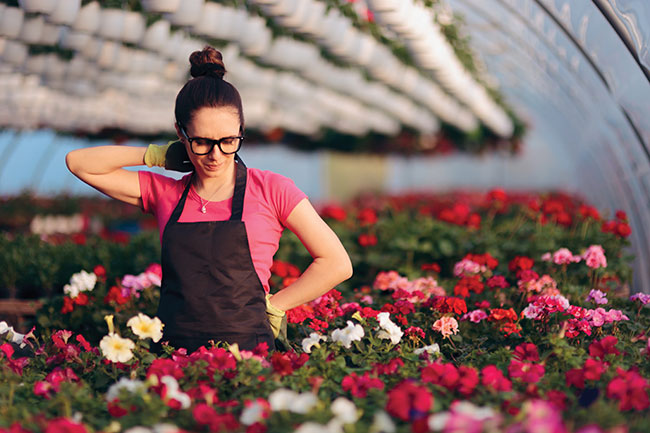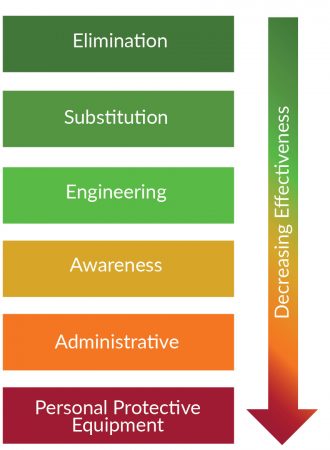
Features
Labour
Management
Relieving the pains of greenhouse work
With plenty of repetitive motions needed to fulfill common tasks in the greenhouse, workers are prone to developing musculoskeletal disorders.
January 26, 2021 By Don Patten
 Photo credit: © nicoletaionescu / iStock / Getty Images Plus
Photo credit: © nicoletaionescu / iStock / Getty Images Plus I shop a bit differently these days. Thanks to my job, a “Product of Ontario” sticker means a lot more. Having witnessed the dedication that goes into each fruit, vegetable and plant for sale, I am keenly aware of the effort and impacts greenhouse production can have on the workers involved.
Workers in action
It was an eye-opening experience, the first time I set foot in a greenhouse.
I was immediately thankful to be there; welcomed in from the cold, to a warm oasis filled with beautiful sights and smells. Everywhere I looked, I saw employees working diligently to plant, cultivate and harvest delicate greenhouse plants.
Not invited to simply look, I quickly got to work; my health and safety training springing into action.
It didn’t take long for me to realize greenhouse workers wore many hats; responsible for a wide variety of tasks. Often manual in nature, they performed repetitive tasks involving the use of their hands for extended periods of time and were required to lift an assortment of heavy objects. They also operated an array of machinery such as tractors, forklifts, skid steer loaders and other specialized horticulture equipment.
MSDs apparent
During my visit, it became obvious that greenhouse workers were susceptible to developing musculoskeletal disorders (MSDs).
A term used to describe a number of different aches and pains affecting the musculoskeletal system (your muscles, tendons, and nerves); common MSDs include back pain, carpal tunnel syndrome, and tendonitis. Symptoms range from pain, stiffness, swelling, tenderness, tingling or numbness, to a limited range of motion.
MSDs can occur suddenly or develop gradually over time. They are linked to known hazards in the workplace, alone or in combination:
- Forceful exertions
- Fixed or awkward postures
- Repetitive actions
The good news about MSDs is that they can be prevented.
Protecting workers
Legally, employers have a duty to protect their workers from MSDs.
In Ontario, employers are required by law to take every reasonable precaution to protect workers from hazards, including those that may cause MSDs (Occupational Health and Safety Act, 25(2)(h)). In addition, the government of Canada’s Occupational Health and Safety Regulations list specific requirements to help employers prevent musculoskeletal injuries (Part XIX).
If ignored, MSD injuries can be costly to a business’ bottom line. An injured employee can lead to lost productivity, insurance claims and premium hikes, costs related to hiring and training new employees, and/or WSIB premium rate increases.
Luckily, MSD prevention doesn’t have to be costly or difficult.
Stopping MSDs before they stop you
Whether your business is provincially or federally regulated, Canada’s Guide on the Prevention of Musculoskeletal Injuries or the Musculoskeletal Disorder (MSD) Prevention Guideline for Ontario are fantastic resources for implementing an MSD prevention program in your workplace.
To get you started, here are some basics for workplace compliance and MSD worker well-being.
Education
As mentioned earlier, employers are legally bound to protect their workers and provide them with the information, instruction and supervision necessary.
As MSDs are often less obvious than a tripping hazard or a sharp blade, education is even more important. Ensure workers know the hazards and can identify MSD symptoms. For greenhouse workers, this could be a heavy and/or tingling feeling in their wrist from repetitively pruning, low back tightness from moving heavy potted plants, or elbow pain from repetitive and forceful gripping.
Early detection and reporting symptoms to supervisors is key to preventing injury.
Risk Assessments
A crucial step in any safety program is to complete a risk assessment. Take time to understand the tasks of your workers and determine the risks that could cause them harm.
Although this may sound like a substantial task, it will save you time and effort in the long run. A risk assessment will help you target your efforts and realize more effective results. Ontario employers can use the Workplace Safety & Prevention Services (WSPS) free MSD Risk Assessment template to help them get started.

The hierarchy of controls can help operators identify which types of interventions to apply. Photo credit: © 2020, Workplace safety & prevention Service (WSPS)
Inspections
OHSA Clause 25(1)(b) mandates that Ontario employers ensure equipment, materials and protective devices are provided to their workers and that they are in good working order. This requires regular assessments and should be a shared responsibility between the employer and their workers.
Monthly inspections by the greenhouse’s joint health and safety committee (for businesses with 20 or more employees) or identified health and safety representatives (for businesses with six to 19 employees) should also take place to identify any health and safety concerns – including MSDs. And, for ultimate effectiveness, all employees should be involved in developing solutions. This helps ensure the solution is practical and will increase the chances of adoption among workers.
Interventions
Once a hazard is identified, it’s time to find a solution. Interventions can take many shapes. For MSD hazards – like those found in greenhouses – the application of ergonomic principles is key.
Ergonomics is the science of matching the job to the physical and mental capabilities of the worker. Its goals are to:
- reduce, prevent and/or eliminate injuries and health disorders associated with the overuse of specific muscles and tissues;
- improve productivity;
- and enhance the quality of work.
Use the Hierarchy of Controls to identify what type of intervention to apply.
The most effective way to prevent MSDs is to eliminate the hazard or find a substitution. For example: Lifting heavy objects – commonplace in a greenhouse – places excessive force on the back. Can you remove this task? Is it necessary? Can improvements be made to ensure it’s done in a consistently safe manner (e.g. introducing a plant cart to lift and move trees)?
The introduction of engineering controls (adjustment to work stations, opportunities to automate planting, placing, harvesting and packaging processes, etc.) to remedy MSD hazards has become increasingly popular due to their ability to create production efficiencies at the same time. Some greenhouse specific examples include:
- Height adjustable sleeving workstations
- Height adjustable rose bunching workstations
- Raised troughs to improve working heights
Next, you have simple and effective awareness controls such as staff education/communication on proper lifting techniques, stretch break reminders, etc.
The implementation of administrative controls can help as well. These are policy or procedural changes, such as altering work hours, implementing job rotation or changing break schedules.
Lastly, if there is Personal Protective Equipment (PPE) provided, employers must ensure it fits properly and is appropriate for the task.
Be your own advocate
Although many interventions involve the employer, workers can take action to protect themselves too.
- Participate in training.
- Follow safe work practices and use the equipment provided.
- Be aware of your work habits.
- Identify and report MSD hazards.
- Report any discomfort/MSD symptoms. And, report it early before serious harm occurs.
- Avoid repetitive movements and/or look for opportunities to vary your tasks.
- Take breaks to rest your body.
- Seek assistance when a job requires heavy lifting
A little help from your friends
My observations were recently validated on a much larger scale during the Greenhouse Risk Assessment Project conducted by WSPS and the Ontario Ministry of Labour, Training and Skills Development (MLTSD).
This multi-year project brought together employers and workers of flower and vegetable greenhouses to explore industry specific risks. Results identified MSDs – specifically overexertion, repetitive strain, bending and twisting, pull force hazards – to be the top concern among vegetable greenhouses and the second biggest concern for flower greenhouses. (Visit greenhousecanada.com/webinars to watch a recording of a recent webinar presentation by WSPS.)
A root-cause analysis exercise is planned with vegetable greenhouses in spring 2020 to identify causal factors. Afterwards WSPS will collaborate with industry groups to select, adapt or develop intervention strategies to address the major root causes identified. The end-goal is to raise hazard awareness among the industry and provide greenhouse-specific, easily adoptable and effective health and safety interventions.
Greenhouse industry, fear not. Help is on its way.
Don Patten is a Registered Kinesiologist and Canadian Certified Professional Ergonomist with Workplace Safety & Prevention Services (WSPS); a health and safety association responsible for over 170,000 member firms and 4.2 million workers across Ontario’s agricultural, manufacturing and service sectors.
Print this page